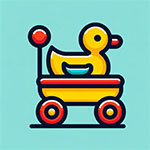
The first year of a baby’s life is a magical time filled with many firsts. Among these firsts, the introduction to Activities of Daily Living (ADLs) plays a pivotal role in a child’s development. ADLs, typically associated with self-care tasks such as feeding, dressing, and grooming, are foundational skills that everyone needs to master to function independently. However, when it comes to infants, ADLs also encompass the basic interactions and experiences that foster cognitive, emotional, and physical growth.
Introducing babies to ADLs during their first year is not just about preparing them for the practical aspects of daily life. It’s about nurturing their curiosity, encouraging exploration, and supporting their developmental milestones. From grasping a spoon to responding to their name, each activity is a stepping stone towards independence and self-reliance.
Understanding ADLs in Infancy
The Essence of ADLs for Infants
Activities of Daily Living (ADLs) are the cornerstone of our everyday routines, encompassing fundamental self-care tasks that enable independence. While ADLs for adults might include cooking, cleaning, or managing finances, for infants, these activities are centered around their immediate needs and interactions with the world. In the first year of life, ADLs focus on feeding, dressing, bathing, and playing—each serving as a vital component of their developmental journey.
Developmental Milestones and ADLs
Integrating ADLs into an infant’s daily life supports a spectrum of developmental milestones. From physical growth, such as fine motor skills and hand-eye coordination, to cognitive advancements like problem-solving and understanding cause and effect, ADLs offer a natural and engaging way to foster early development. Emotional and social skills also benefit as babies learn to communicate their needs and begin to understand the roles of those around them.
- Feeding: Introducing different textures and self-feeding practices can promote sensory development and fine motor skills.
- Dressing: Encouraging infants to touch and explore different fabrics aids in sensory awareness, while assisting in dressing fosters independence.
- Bathing: Water play not only supports physical development but also introduces concepts of cleanliness and self-care.
Supporting Infant ADLs
Parents and caregivers play a pivotal role in introducing ADLs. This support involves creating a safe and stimulating environment where infants can explore and learn. Choosing age-appropriate toys and tools, such as soft spoons, textured fabrics, and bath toys, can make these activities both educational and enjoyable. Observing your child’s cues and readiness for new challenges is crucial, as each baby progresses at their own pace.
Embracing ADLs in infancy lays the foundation for lifelong skills in self-care and independence. By integrating these activities into daily routines, parents provide their children with the building blocks for success in all aspects of their development.
Month-by-Month Guide to Introducing ADLs
Birth to 3 Months: Discovering the World
Developmental Milestones:
- Begins to develop a social smile.
- Starts to track objects with eyes.
- Shows recognition of familiar people and objects.
Activities to Encourage ADLs:
- Feeding: Introduce a routine that allows your baby to anticipate feeding times, helping establish a sense of security.
- Dressing: Use dressing times to gently massage your baby’s limbs, promoting bonding and sensory experiences.
- Bathing: Make bath time soothing with gentle water play, encouraging sensory development.
4 to 6 Months: Exploring Through Touch
Developmental Milestones:
- Grasps objects and brings them to mouth.
- Begins to show curiosity and reach for objects.
- Recognizes familiar faces and starts babbling.
Activities to Encourage ADLs:
- Feeding: Introduce a variety of textures through safe, baby-friendly utensils and encourage exploration of soft, baby-safe foods.
- Dressing: Encourage your baby to touch different fabrics and gently help guide their hands during dressing.
- Bathing: Introduce colorful, waterproof toys to make bath time an opportunity for play and learning.
7 to 9 Months: Becoming Active Participants
Developmental Milestones:
- Sits without support and starts to crawl.
- Begins to understand object permanence.
- Shows preferences for certain people and toys.
Activities to Encourage ADLs:
- Feeding: Promote self-feeding with finger foods to develop fine motor skills and independence.
- Dressing: Encourage your baby to participate in dressing by pushing through arms in sleeves or lifting legs.
- Bathing: Allow supervised splashing to develop motor skills and introduce concepts of cause and effect.
10 to 12 Months: Mastering New Skills
Developmental Milestones:
- Stands with support and may take first steps.
- Can follow simple directions and understands no.
- Uses simple gestures like waving bye-bye or shaking head.
Activities to Encourage ADLs:
- Feeding: Introduce utensils like spoons and encourage attempts at self-feeding, even if messy.
- Dressing: Encourage identification of simple clothing items and attempt to put them on with assistance.
- Bathing: Encourage play that involves filling and emptying containers to enhance fine motor skills and understanding of quantities.
Each stage of development in the first year of life brings new opportunities for learning and growth through ADLs. By tuning into your baby’s cues and gently introducing new activities, you can support their journey toward independence while fostering a deep bond. Remember, every child develops at their own pace, so these activities should be adapted to meet your baby’s unique needs and abilities.
Creating a Stimulating Environment for ADLs
A nurturing and stimulating environment is crucial for a baby’s development, especially when introducing them to Activities of Daily Living (ADLs). The arrangement of physical space, choice of toys, and daily routines all play significant roles in encouraging growth and learning. Here are strategies to create an enriching space that supports the development of ADLs.
Tailoring Your Space
- Safe Exploration Area: Dedicate a safe, baby-proofed area where your infant can explore freely. This space should have a soft floor and be away from sharp corners, electrical outlets, and small objects that pose a choking hazard. Encourage mobility and exploration with colorful mats, mirrors, and age-appropriate toys that stimulate crawling and movement.
- Interactive Zones: Set up specific areas for different activities. A comfortable, quiet corner can be ideal for feeding and cuddling, while a well-lit table with chairs (for older babies) can serve as a spot for experimenting with finger foods or playing with toys that enhance fine motor skills.
Selecting Appropriate Toys and Tools
- Sensory Toys: Choose toys that stimulate the senses—bright colors, various textures, and engaging sounds. These can include soft books, rattles, and textured balls. Sensory play aids in cognitive development and helps babies learn more about their environment.
- Problem-Solving Toys: Toys that require manipulation, like simple puzzles, shape sorters, and toys with buttons or levers, encourage problem-solving skills and critical thinking from an early age.
- Imitative Play Materials: Include items that mimic everyday objects, such as toy phones, kitchen sets, and dolls. These toys allow babies to imitate adult activities, fostering creativity and understanding of the world around them.
Establishing Routines
- Consistency is Key: Establishing a consistent routine helps babies feel secure and aids in their understanding of the world. Regular schedules for feeding, sleeping, bathing, and playtime support emotional development and make the introduction of new ADLs smoother.
- Active Participation: Encourage your baby to take an active part in routines as they grow. Simple actions like holding a bottle, choosing a book for bedtime, or helping to put toys away can promote independence and self-esteem.
By creating a stimulating environment and incorporating these strategies into your daily routine, you’re not just facilitating physical and cognitive development; you’re also laying the groundwork for a lifetime of learning and independence. These early experiences with ADLs, set within a supportive and enriching space, are invaluable in nurturing your baby’s potential.
Challenges and Solutions
Introducing your baby to Activities of Daily Living (ADLs) is an essential part of their development but can sometimes present challenges. Here are common issues parents may encounter and practical solutions to help overcome them.
Challenge 1: Resistance to New Activities
Solution: Babies might resist new activities for various reasons, including discomfort, unfamiliarity, or just being in a bad mood. It’s essential to introduce new ADLs gradually and at the right time. Look for cues that your baby is rested, alert, and in a good mood before trying something new. Always approach activities with patience and encouragement, turning them into playful and enjoyable experiences. If resistance persists, take a break and try again later.
Challenge 2: Safety Concerns
Solution: Safety is a paramount concern when introducing babies to new activities. Always supervise your baby closely and baby-proof your home to prevent accidents. Use age-appropriate toys and tools to ensure they’re safe for your baby’s current developmental stage. If you’re unsure about the safety of an activity, consult your pediatrician for guidance.
Challenge 3: Slow Progress
Solution: Every baby develops at their own pace, so what works for one child may not work for another. If you’re concerned about your baby’s progress with certain ADLs, remember that variability in development is normal. Celebrate small milestones and provide continuous support and encouragement. If developmental delays are a concern, discuss them with your pediatrician, who can provide reassurance or recommend further evaluation.
Challenge 4: Parental Frustration and Fatigue
Solution: It’s normal for parents to feel frustrated or overwhelmed by the challenges of introducing ADLs, especially when progress seems slow. Remember to take care of yourself and seek support from family, friends, or parent groups. Sharing experiences and strategies with others can provide new ideas and emotional support. It’s also important to acknowledge your efforts and the progress you and your baby are making.
Challenge 5: Finding the Right Resources and Tools
Solution: With so many products on the market, finding the right toys and tools to support your baby’s ADLs can be daunting. You can find some of our recommendations for toys that will support your child’s development here: Developmental Toy Recommendations. Your pediatrician may also be able to provide some recommendations.
Facing challenges is a natural part of parenting, especially during your baby’s first year of life. By adopting a patient, flexible approach and using the strategies outlined above, you can navigate these challenges successfully. Remember, the goal is to create positive experiences that encourage your baby’s growth and development in a safe, supportive environment.
Conclusion
The journey of introducing your baby to the Activities of Daily Living (ADLs) during their first year is an adventure filled with milestones, challenges, and countless learning opportunities. As we’ve explored throughout this blog, ADLs are not just about basic self-care tasks; they’re fundamental experiences that foster growth, development, and independence from the earliest stages of life. By engaging your baby in these activities, you’re laying the groundwork for their future, equipping them with the skills and confidence they need to navigate the world around them.
We’ve seen how, month by month, babies can gradually be introduced to new ADLs, starting from simple interactions like social smiles and tracking objects to more complex tasks such as self-feeding and participating in dressing. Creating a stimulating environment plays a crucial role in this process, providing a safe space for exploration and learning. Challenges along the way are inevitable, but with patience, persistence, and the right strategies, they can be overcome, enriching the parenting experience and fostering a deeper bond with your child.
As you embark on this journey with your little one, remember that each baby’s path to mastering ADLs is unique. Celebrate every achievement, no matter how small, and approach each challenge with a problem-solving mindset. The experiences you create now are not just about meeting developmental milestones; they’re about building a foundation of love, trust, and independence that will last a lifetime.
In closing, we encourage parents to be patient and persistent in introducing their babies to ADLs. The efforts you put in today are an investment in your child’s future, setting them up for success in all areas of life. The first year of your baby’s life is a precious time of growth and discovery—for both of you. Embrace it with joy, curiosity, and an open heart.
Thank you for joining us on this exploration of introducing babies to Activities of Daily Living. We hope this guide has provided you with valuable insights, practical tips, and, most importantly, the confidence to support your baby’s journey towards independence and self-reliance. Here’s to a year filled with growth, learning, and unforgettable moments with your little one!





